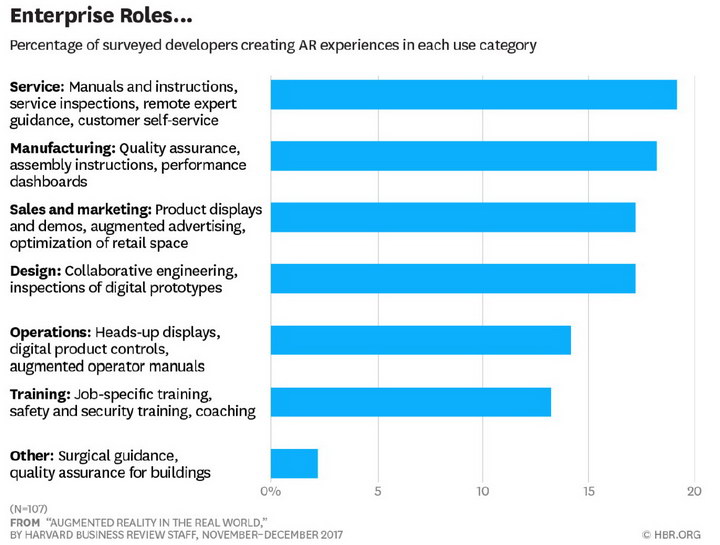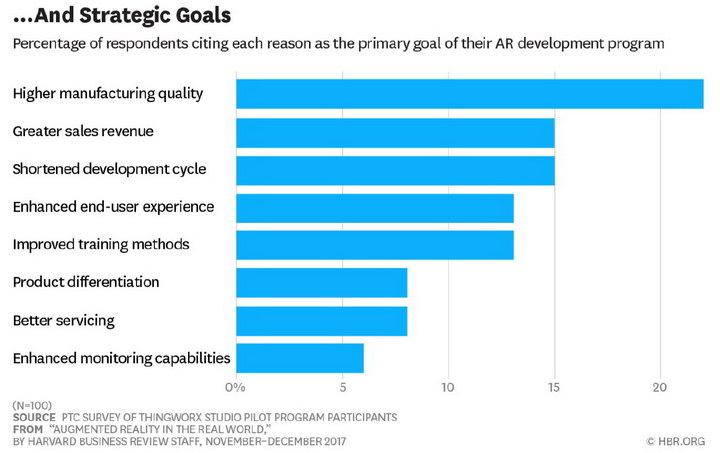Supporters of augmented and virtual reality keep saying that AR/VR technology is going mainstream. In the business world perhaps there is nothing more mainstream than the Harvard Business Review (HBR).
What do they have to say about virtual and augmented reality? It turns out the HBR says very little about VR but there is a significant amount of optimism for AR in the enterprise space.

My attention to the HBR was sparked by an article titled “How Augmented Reality Will Make Surgery Safer” by Sarah Murthi, MD and Amitabh Varshney. Dr. Murthi is an Associate Professor of Surgery and Dr. Varshney is Dean of the College of Computer, Mathematical, and Natural Sciences, both at the University of Maryland. They make a convincing argument that AR can improve surgical outcomes by presenting information to surgeons and other operating room personnel in real time – information they can see without glancing away from the patient to look at conventional displays.
The authors also point out that AR in the operating room (OR) can also increase hospital profits – after all this is the Harvard Business Review covering the business aspects of AR, not the American Journal of Surgery covering the medical aspects of AR. ORs, and elective surgery performed in these ORs, are a major source of profits for hospitals. If operations can be streamlined so they take less time without increasing patient risk, more surgery can be scheduled into the OR and provide more profits. The authors point out that surgery is already pretty safe so hospital administrators shouldn’t expect a dramatic drop in surgical problems with the introduction of AR although any improvement in medical outcomes is always desirable.
Augmented reality could superimpose critical clinical data directly on the surgeon’s view of the patient. (Source: The Augmentarium at the University of Maryland; illustration by Brian G. Payne; via HBR)I searched the HBR for other AR and VR articles and the most interesting one I found was a group of five articles, collectively called A Manager’s Guide to Augmented Reality in the November – December 2017 issue. This guide can be accessed for free as one of three articles non-subscribers can read. The five articles were:
- Why Every Organization Needs an Augmented Reality Strategy by Michael E. Porter (Professor at the Harvard Business School) and James E. Heppelmann (President and CEO of PTC);
- How Does Augmented Reality Work? also by M. Porter and J. Heppelmann;
- Augmented Reality in the Real World by the Harvard Business Review Staff;
- One Company’s Experience with AR is an interview with Guido Jouret, chief digital officer at ABB by Gardiner Morse, a senior editor at the HBR and;
- The Battle of the Smart Glasses by M. Porter and J. Heppelmann.
Any business manager that wonders why his company should be interested in AR needs to read Why Every Organization Needs an Augmented Reality Strategy. This is the longest article of the five and gives the arguments for AR and the applications of AR in the business world in a coherent and literate way, as you would expect from a Harvard-sponsored publication. Most DD readers interested in AR have heard these arguments and applications before so I won’t go into them in detail.
The material in How Does Augmented Reality Work? should also be familiar to most DD readers. It goes into not just the head-mounted displays but also on the software and systems that drive them, giving a good overview. The Battle of the Smart Glasses is perhaps the least interesting article since it goes into the details of commercially available AR HMDs. Any November 2017 article on AR HMDs is bound to be obsolete by August 2018.
Perhaps the most interesting article of these five for DD readers was Augmented Reality in the Real World. Most of the information in this article is from the PwC (PricewaterhouseCoopers) 2017 Global Digital IQ Survey, taken by 2,216 business and IT executives from 53 countries. PwC is, perhaps, even more mainstream in the Enterprise World than the HBR!
 AR Investment plans from the PwC Survey (Source: HBR)As can be seen, the Automotive industry currently (i.e. in 2017) invests the most in AR technologies and will continue to be one of the top investors in 2020, if the executives and IT people who took the survey have their way. But still, even though automotive is one of the big industrial AR users, only about 18% of companies made “substantial” investments in 2017 and only about 31% expect to make substantial investments in 2020. The hospitality and leisure industries are at the bottom of the list for 2017 with only about 5% making substantial investments. Not surprisingly there is an expected sharp increase by 2020, but still only to 20% of the industry. From this survey data, I would conclude that it is still only a minority of enterprises that see VR as a must-do investment for the near future.
AR Investment plans from the PwC Survey (Source: HBR)As can be seen, the Automotive industry currently (i.e. in 2017) invests the most in AR technologies and will continue to be one of the top investors in 2020, if the executives and IT people who took the survey have their way. But still, even though automotive is one of the big industrial AR users, only about 18% of companies made “substantial” investments in 2017 and only about 31% expect to make substantial investments in 2020. The hospitality and leisure industries are at the bottom of the list for 2017 with only about 5% making substantial investments. Not surprisingly there is an expected sharp increase by 2020, but still only to 20% of the industry. From this survey data, I would conclude that it is still only a minority of enterprises that see VR as a must-do investment for the near future.
 Enterprise Role of AR (Source: HBR)The survey shows what role in the enterprise these AR investments are expected to play. These roles pretty much match the roles suggested by AR HMD and system developers.
Enterprise Role of AR (Source: HBR)The survey shows what role in the enterprise these AR investments are expected to play. These roles pretty much match the roles suggested by AR HMD and system developers.
 Strategic Goals for AR Investments (Source: HBR)
Strategic Goals for AR Investments (Source: HBR)
The strategic goals of the participants in this survey all seem to be bottom-line oriented, as would be expected in a PwC survey reported in the HBR. The top goal is improved quality for manufactured goods and the number two and three goals are greater sales revenue and shorter development times – all good contributors to an enterprise’s bottom line. Fourth on the list is enhanced end-user experience, which doesn’t directly reflect on the corporate bottom line. With it’s companion, product differentiation, sixth on the list, these two factors can lead to greater sales revenue. Note this survey doesn’t differentiate between in-house application of AR (e.g. improved quality) and product designs that include AR (e.g. enhanced end-user experience).
The HBR article also presented a forecast from IDC for growth of AR HMD sales 2017 – 2021. Since more recent data is readily available from IDC, I won’t repeat that out-of-date chart. I will note that the AR HMD sales forecast in the 2017 IDC report for 2021 was about 21 million units and the 2021 forecast from their 2018 report was only about 17 million units. This just validates my long-term stand: any specific AR or VR forecast should be taken with a grain of salt.
 Guido Jouret answers a series of questions posed by the HBR about AR in the article One Company’s Experience with AR. Jouret joined the Swiss industrial giant ABB in 2016, after spending more than two decades in technology leadership roles at Cisco and Nokia. As chief digital officer, he helps lead the $34 billion company’s technology strategy in green power, transportation, robotics and automation in over 100 countries, and he champions its AR initiatives.
Guido Jouret answers a series of questions posed by the HBR about AR in the article One Company’s Experience with AR. Jouret joined the Swiss industrial giant ABB in 2016, after spending more than two decades in technology leadership roles at Cisco and Nokia. As chief digital officer, he helps lead the $34 billion company’s technology strategy in green power, transportation, robotics and automation in over 100 countries, and he champions its AR initiatives.
He sees short and medium term application of AR will be most important in three categories of enterprise tasks. First, dangerous tasks. It may not be possible to entirely eliminate workers from dangerous tasks, but maximizing the information the worker has and providing back-up expert help using the camera on the AR HMD can minimize worker danger and the possibility of damage to expensive equipment. Second, AR is appropriate for remote tasks. Travel is expensive and it is sometimes hard to get a worker to a needed location. If the equipment is designed so he can work remotely, this will minimize not only costs but also danger. By eliminating travel, it also minimizes the lag time between when it is realized that equipment needs repair or adjustment and when the work is actually done. Finally, Jouret says, there are tasks that are simply too complex to be automated. Again, by maximizing the information a worker has and using back-up, remote expert help, these tasks can be performed efficiently. He says “It probably shouldn’t be a priority to add AR to a simple machine that’s easily accessible.”
One of the questions posed for Jouret was “Do businesses have unrealistic expectations about AR because of hype on the consumer side?” His answer was:
Actually, I think it’s sometimes the reverse—press about consumer uses of new technology negatively influences the perception of that technology in business. It’s a recurring theme. Think of the press around consumer drones, for instance, which suggests that they’re a nuisance or a toy. But of course we’re finding important applications in industry now for inspecting refineries, pipelines, and high-voltage transmission lines. Same thing goes for blockchain, which at first was seen as the technology behind bitcoin, the digital currency used by drug dealers. But businesses are beginning to understand that blockchain will have a huge impact on contracts. AR was seen as a game platform, and there was bad press when Google Glass stalled, which may have colored how businesses saw the technology—maybe as a science experiment that wasn’t going anywhere. But people who actually work with AR in the industrial space are quite excited.
There you have it: a mainstream view of the future of Augmented Reality in the enterprise market. It is seen as something that is not just coming but is already here for certain applications such as corporate training. There will be more AR in enterprise applications by 2020 and presumably, still more in the years after that. –Matthew Brennesholtz

